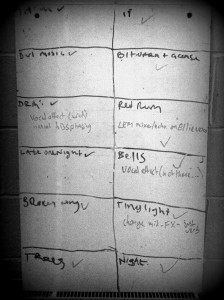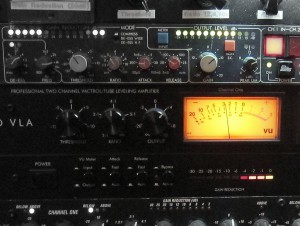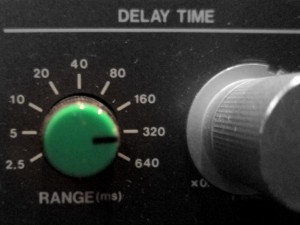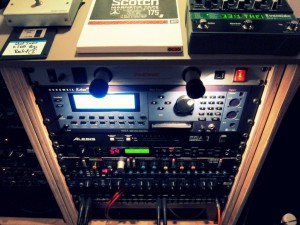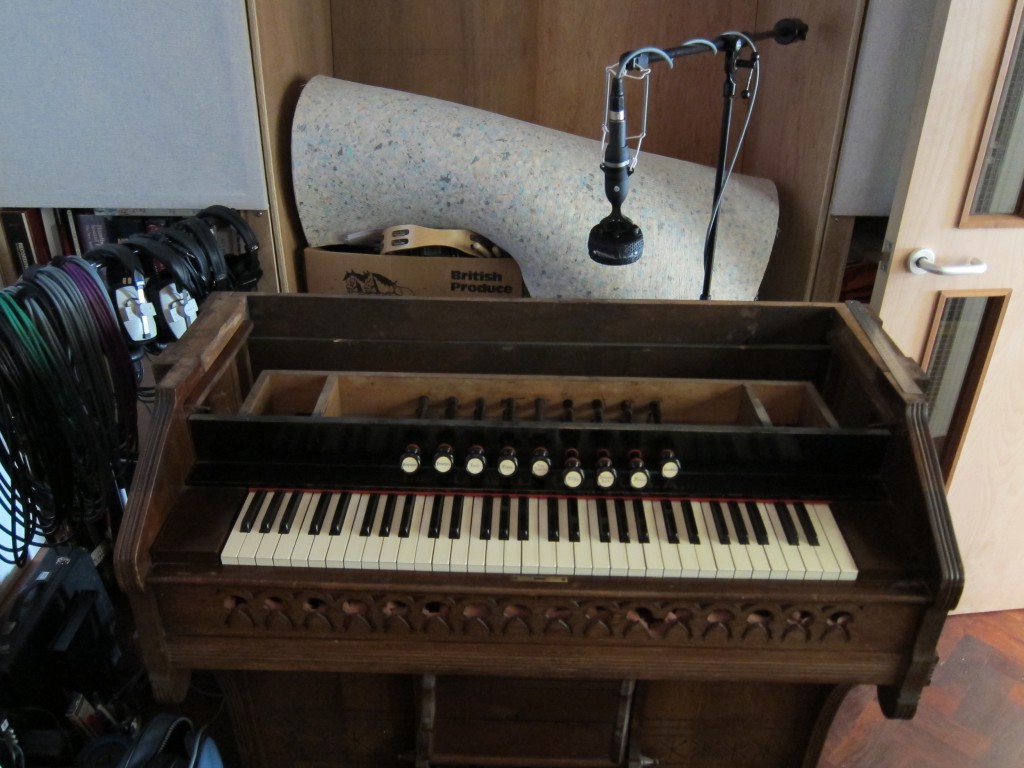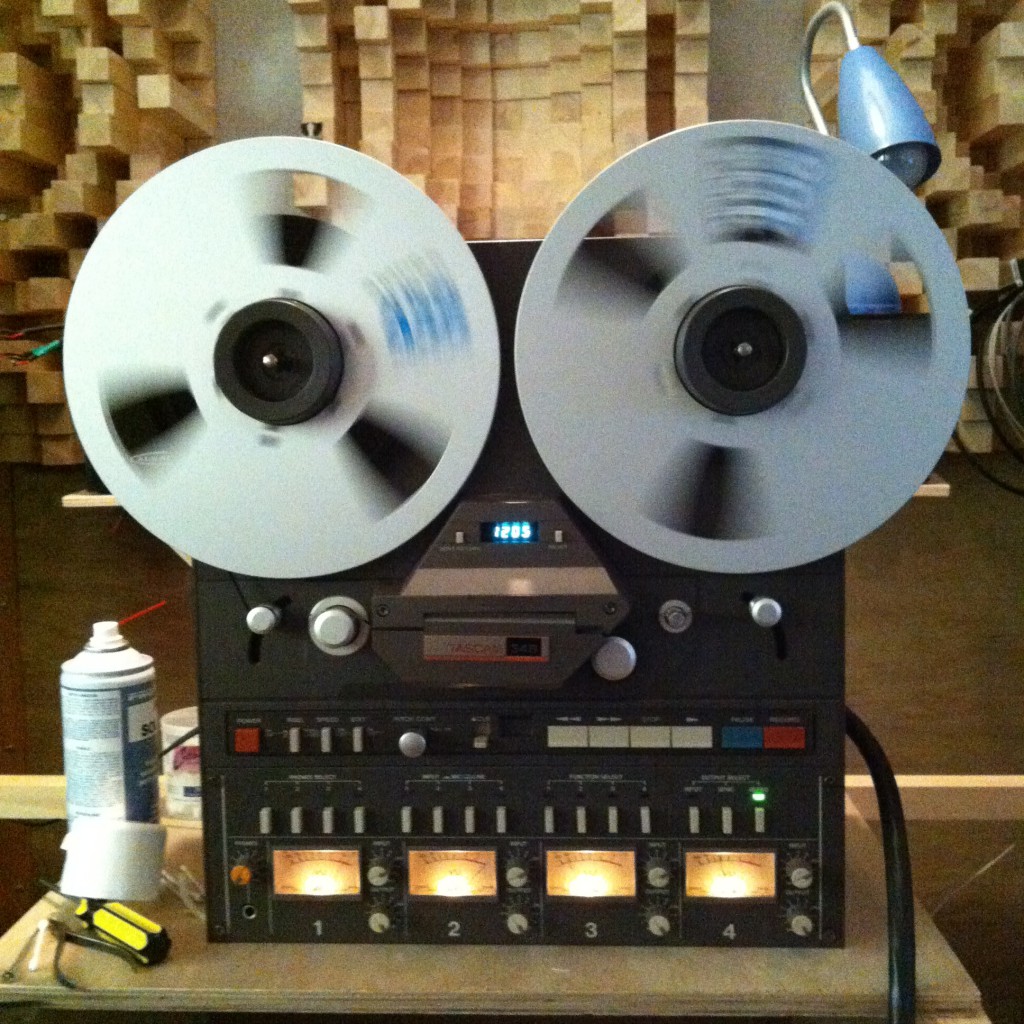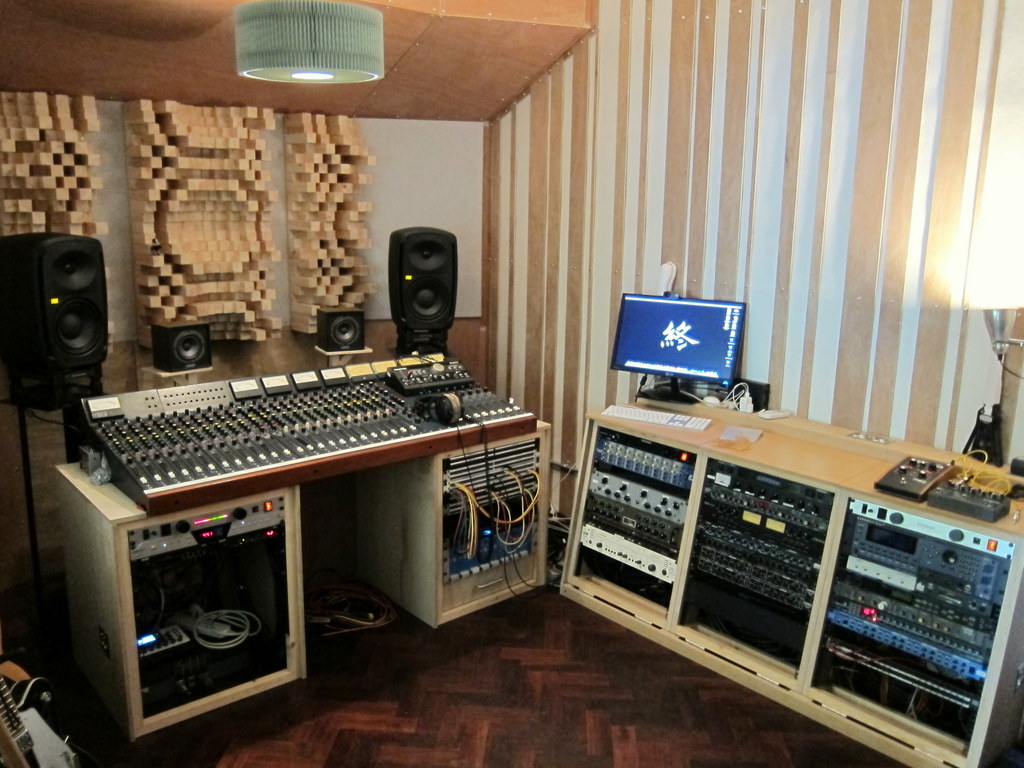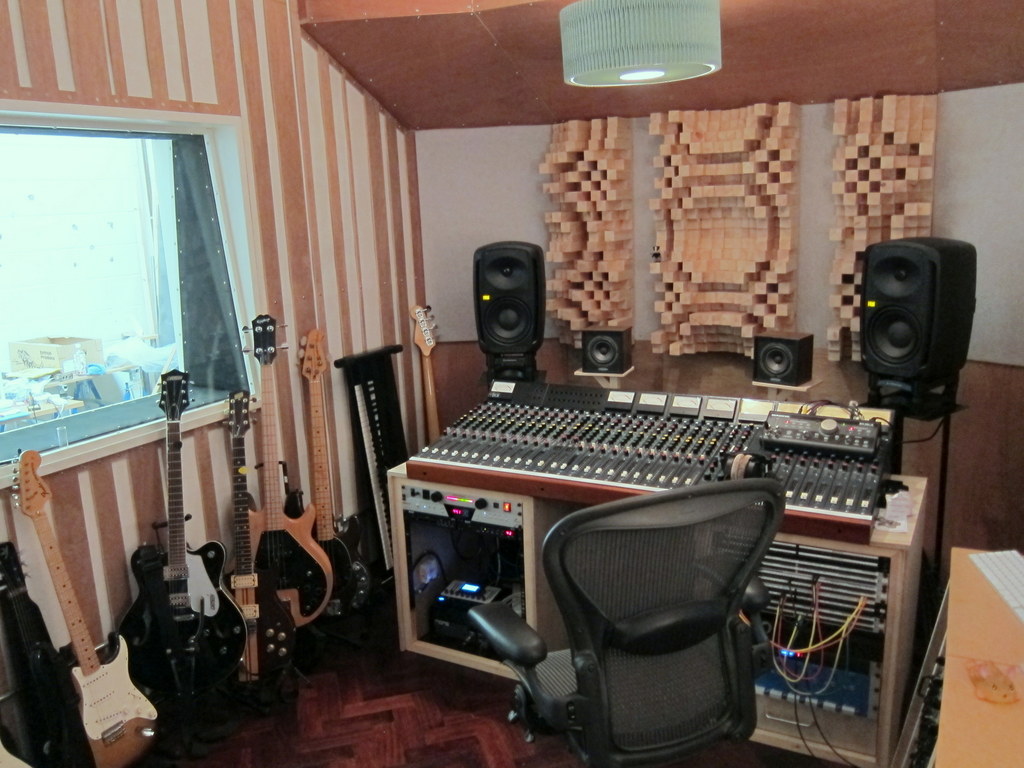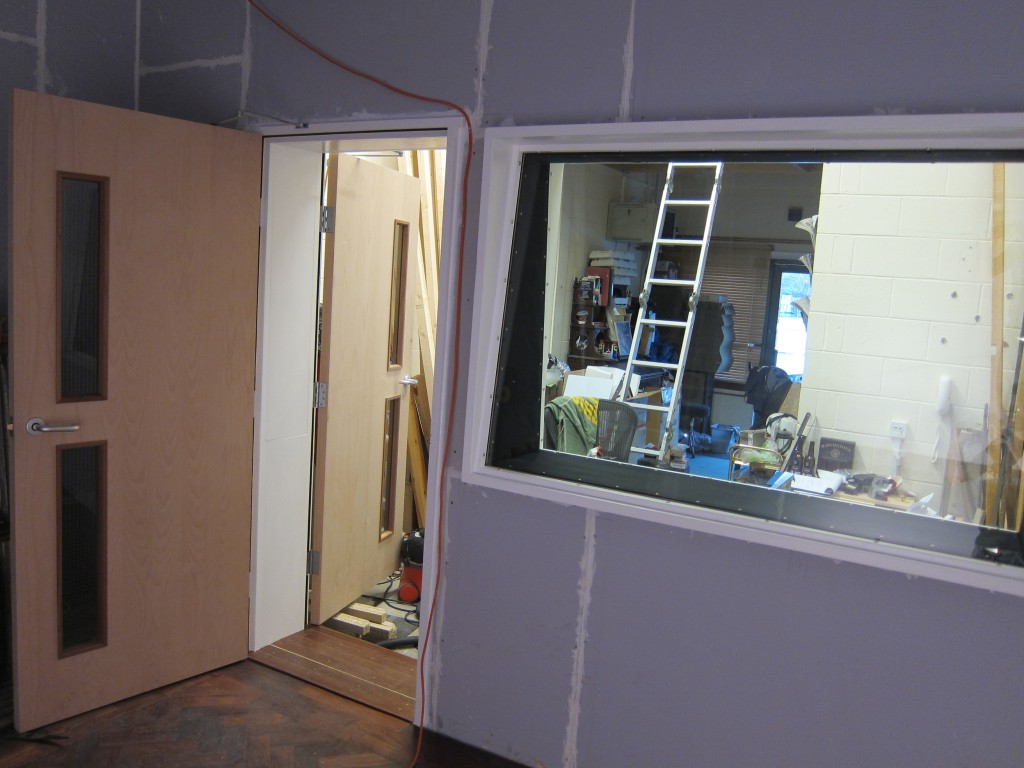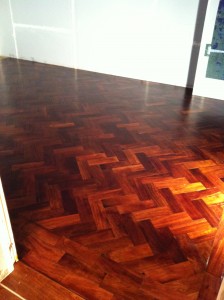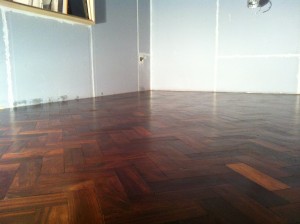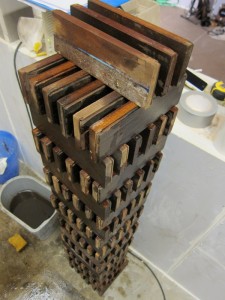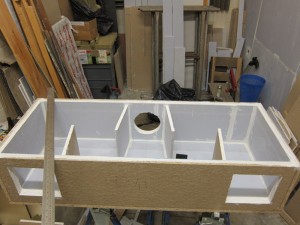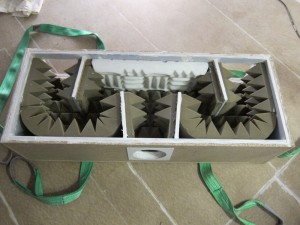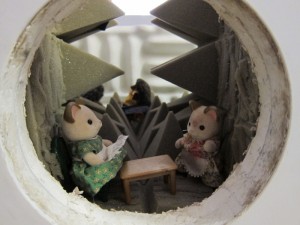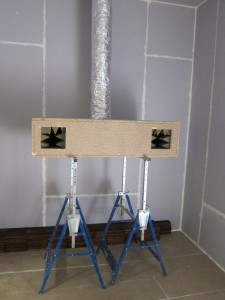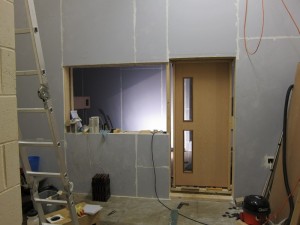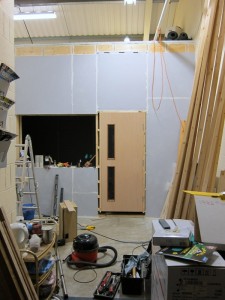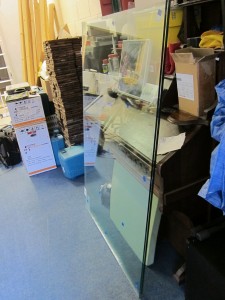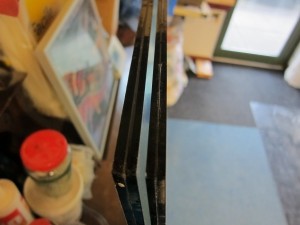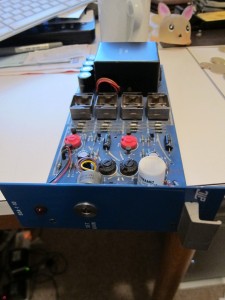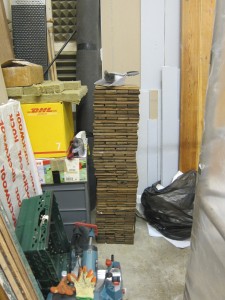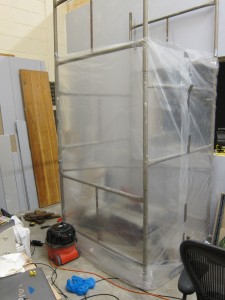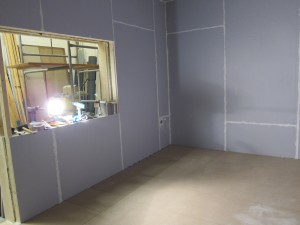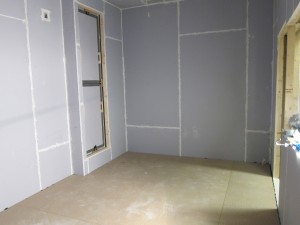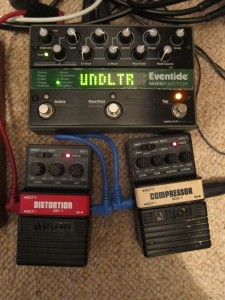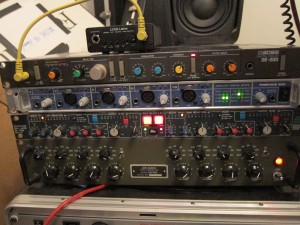Once upon a 1988 I moved from Norwich to Oxford with my Mum to study for A-levels (and get out of Norfolk!). I was obsessed with music and had been playing bass in a jangly guitar band called Gutter Reaction until I left ‘Narch’. One of my first orienteering missions upon arrival in Oxford was to find record shops (these were the days of Manic Hedgehog and Green River I think). On one such search I happened across a free music paper called Local Support which carried a callout for contributors. The next meeting was to be held at the Jericho Tavern, a pub with which I was to soon become intimately acquainted. This is where I met Local Support lynchpin and future Ride manager Dave Newton whom, despite being older, I felt some form of kinship – it might have been the absurd 80s hairstyles we both sported, but most likely it was his obvious drive to get shit done. Whilst I halfheartedly stumbled through my A-levels I continued to write for Local Support and then Gig, as it became in 1989.
After a somewhat underwhelming response to the Local Support showcase at the Oxford Apollo Theatre (headlined by the awesome Shake Appeal who split not long after, eventually spawning Swervedriver) Dave set about trying to recoup the lost money (I think it was his own!), which turned out to involve putting on regular gigs upstairs at the Jericho Tavern. I spent many, many nights sitting on the door, stamping hands, taking money (if we were lucky), telling bands where you could buy chips, drinking beer, and of course watching bands…so many bands. As with all such endeavours the majority were dull or plain awful, but in amongst it we’d find jewels. As a reputation built we managed to bring in bigger bands culminating in a fire-capacity-bursting show by Primal Scream (for that one I went and got the chips, only to get harassed by the crowd waiting outside as the band were inevitably late).
Everything changed when we put on local thrash outfit Satan Knew My Father (featuring ex-Shake Appeal, soon to be Swervedriver members) supported by Dave’s mate Steve’s band, Ride. The show had omens to start with as Christian groups had been taking down our posters and generally making noise about the band name – annoying, but funny. I have no recollection of how many people showed up – it’s probably one of those gigs where the people who say they were there far exceed the capacity, which was 150 or less. Anyway, whatever expectations we had about Steve and his three Banbury Art College student friends were pleasantly exceeded as Ride turned out to be really rather good. Having seen so many average bands file through the Jericho, you couldn’t help but notice the rare ones that were the real deal. What happened after that for Ride has been, and surely will continue to be, well documented.
(I recommend watching Jon Spira’s film Anyone Can Play Guitar all about the Oxford music scene from the 80s onward)
For me the gig nights carried on with the associated late-night flyposting, worrying that no one will turn up and comforting young bands that had just soundchecked with Mackie the in-house engineer and disturber-of-the-timid. I was also writing pieces for Gig, which included getting a press pass for Reading Festival ’89 – I felt sooo grown-up wandering around backstage – I was 17! I was given the first Ride demo tape to review, which reading back now makes me cringe and smile – you can tell I was becoming opinionated about recording, which I was doing at home with a pair of tape recorders and a hook-up wire I had soldered.
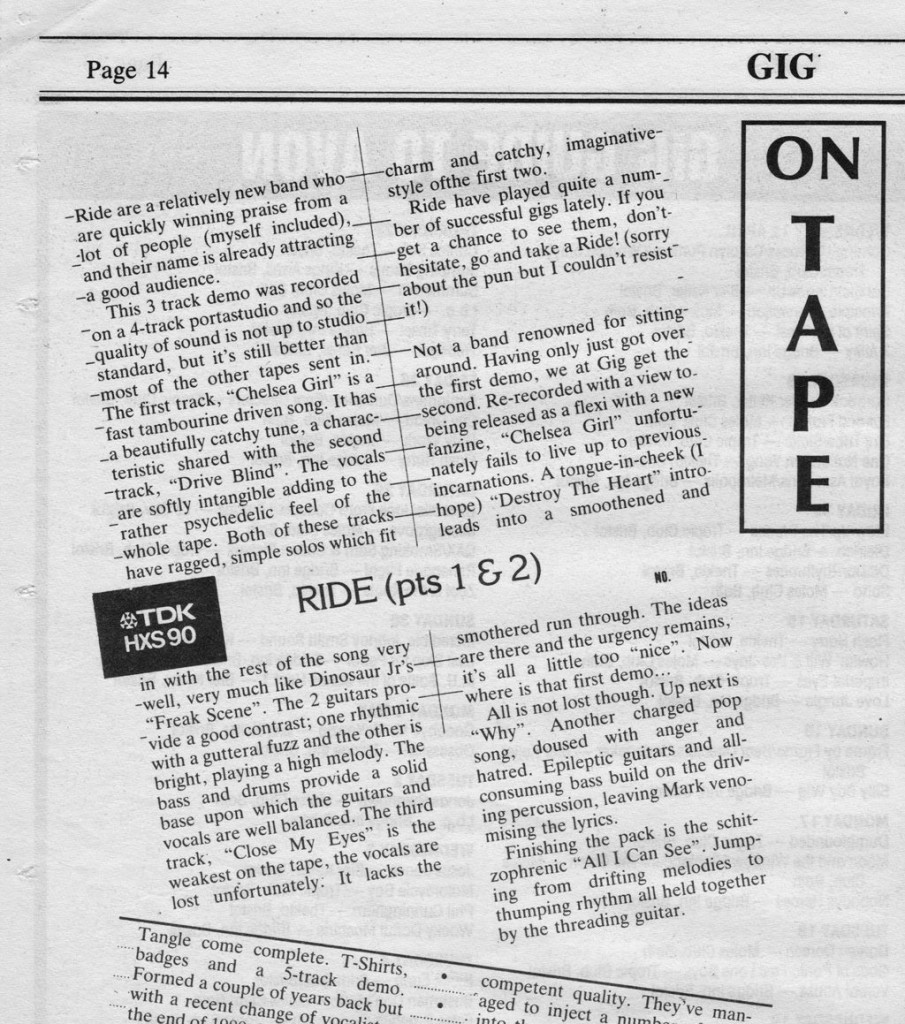
- I wrote part 1 – you can tell. Obviously they never heeded my professional opinion and put Close My Eyes on the first EP – no wonder they never made it!
The band were building a local momentum and in Autumn 1989 they played at Oxford Poly, maybe as headliners, I can’t remember (Mark Taylor, writer of the Ride The Network fanzine will), and it was here that two things happened for me. Firstly Dave Newton had asked me to interview the band for Gig; at this stage I think he had taken on the manager role. The 2 year age-gap between us felt significant to me and their growing reputation made me a little in awe of their ‘cool’. Of course they were happy to talk (I think this was their first ever interview), but I remember finding Steve a little intimidating as he had that ‘doesn’t-suffer-fools’ thing down pat, a quality I came to respect and which has no doubt served him well over the years. As with the tape review, the interview is a cringe-fest for me, as it may well be for the band if they ever read it again.
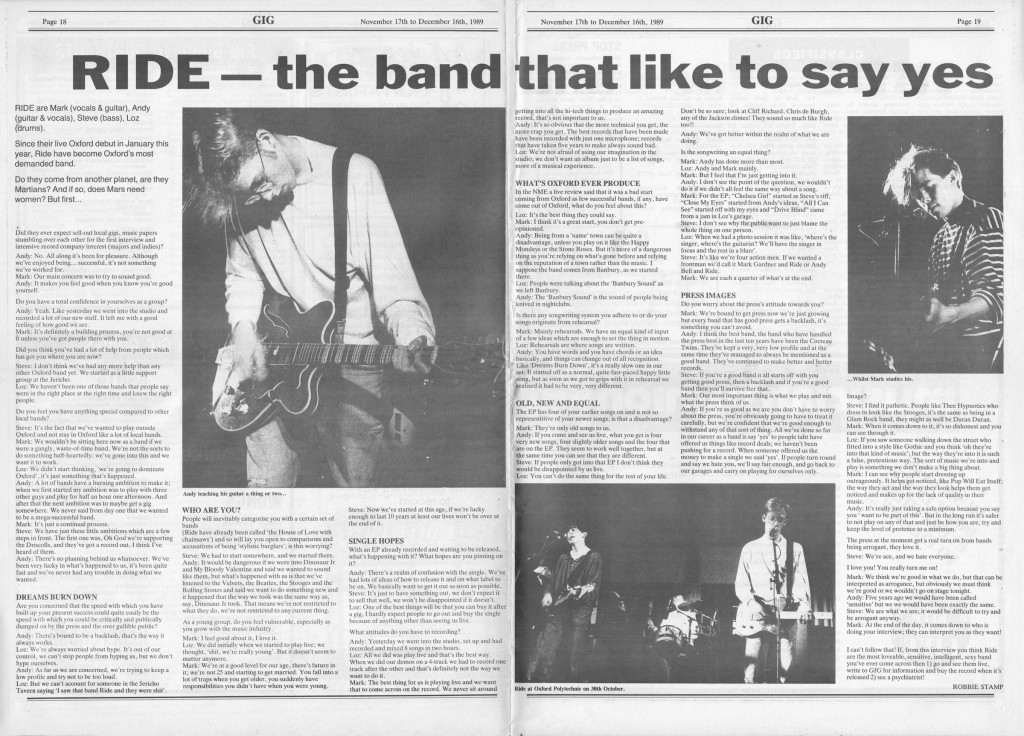
The second, and more significant event was that someone asked if I’d stand at the side of the stage and deal with any string breakages, etc. for the band. It’s funny, as I can’t recall telling people I played bass/guitar, but I must have done to be entrusted with the task. In retrospect it seems strange that I never joined a band in Oxford; I jammed a few times with others, but always became frustrated by their lack of musical ability – picky bugger! Luckily the gig passed without any real call for my limited roadie skills, but over the coming months I was asked back, travelling with the band when I could. A guy called Tommo did many of those early dates and I remember being gutted that I missed the opportunity to be roadie when they appeared on Snub TV, a BBC 2 music show – I probably had some educational reason for not being there.
On the subject of other road crew, during 1990 I was often joined by mate of the band ‘Breezy’ who had no technical skills whatsoever and rarely seemed to lift stuff, but he could score pot anywhere and so earned his place with the band. Dave was less enamoured and at one ULU gig he was fired by an enraged Mr Newton and told he could walk back to Oxford. I felt that same embarrassment I felt as a child when a friend’s parent would tell off their kid whilst you were having dinner at their house, often referencing your own good manners, further impacting the embarrassment. Having returned to the fold Breezy topped his previous efforts (!) by telling German immigration officers that he planned to score drugs when he left the airport – the proceeding hold up didn’t go down well with anyone.
I worked on and off through their first support tour with the Soup Dragons (you had to feel for the headline act – blown-off-stage), through their first two headline tours, European Festivals (Bizarre in Lorelei, Germany and Roskilde in Denmark) and finally Reading Festival 1990, my last date with them. At this point I had only gained one satisfactory A-level and needed to choose between life on the road and an education. Everyone advised the latter, which is what I did, though maybe they were secretly trying to tell me I was a shit roadie. It was a great way to end, soundchecking Steve’s Musicman Stingray whilst looking out across the crowd. There is footage on YouTube of that gig where I can be seen bobbing at the side of the stage keeping an eye on Steve and Loz.
With Ride coming back together this year a mass of memories have unearthed themselves, making me realise how formative these experiences with the band were. We never bonded as friends as such and it was only Dave Newton with whom I sporadically kept in touch, but they exerted a huge influence on my development in relation to my future career. They exposed me to so much great music via mix tapes (mostly Andy’s) in the back of the van. I saw the workings of the music industry from pretty much the moment they entered it: from lawyers meetings to photo shoots to visits to the Creation offices (eye opener!) to ending up in Bobby Gillespie’s (or was it Alan McGee’s?) flat in Brighton thumbing through a truly phenomenal vinyl collection. What really inspired me were the studio visits. I went along for their second Peel session at Maida Vale, helping set up the gear and then sitting in the control room as tape rolled watching Dale Griffin somewhat begrudgingly manhandle the seemingly huge desk (I think it was an SSL as I have a vague memory of the green screen automation monitor). I had seen Dale’s name on the Peel session records in my collection, but the reality was something of a disappointment. At one point the band left the studio and I was on my own tuning guitars or something with Dale miking the drum kit. He hit the 2nd floor tom, made some exclamation and started to complain to me about how dead and slack the head was (he drummed for Mott The Hoople so it was all rather un-drummerly to him). I informed him that Loz had it like that for certain tracks and that he ought to just hoof some reverb on it like they did live – that was the effect – ‘BOOOOFF’. Christ, he grumbled about that and then barely acknowledged me again – I don’t think 18 year olds were welcome in his world! I have carried that experience with me, always striving to be personable and supportive to clients in the studio, knowing how a bad attitude like that can really sour the atmosphere (I don’t how the band perceived it – maybe they missed it – I doubt it though).
The most significant studio experience was visiting the band during the recording of their first album, Nowhere, which took place at Blackwing, which sadly is now closed. My visits were brief, but my eyes were on stalks the whole time; I was particularly taken with the Depeche Mode and Yazoo gold discs on the wall near the MIDI suite, which is something you’d find in studios back then. I was there for the string recording on Vapour Trail, which was a troublesome session as far as I recall (involved a sampler in the end…maybe I shouldn’t say that…ahem), but it was good to see how tricky things get when you’re on the clock. I loved the stone room that gave Loz that enormous drum sound (Dreams Burn Down), and this opened my mind/ears to the acoustic possibilities of studio spaces. Some years ago when I started to really learn about studio design I came across a book by Philip Newell (Recording Studio Design) which became my bible, and lo and behold in it he talks about the very same stone room (see below). One other studio that piqued my interest was Porky’s Prime Cuts mastering room where I sat through the recut of the Play EP (the first lacked top end), watching the engineer work the lathe. It was all an education and inspiration that I never consciously followed, but after my degree in English and Religion it was the only logical conclusion to the choices I made.
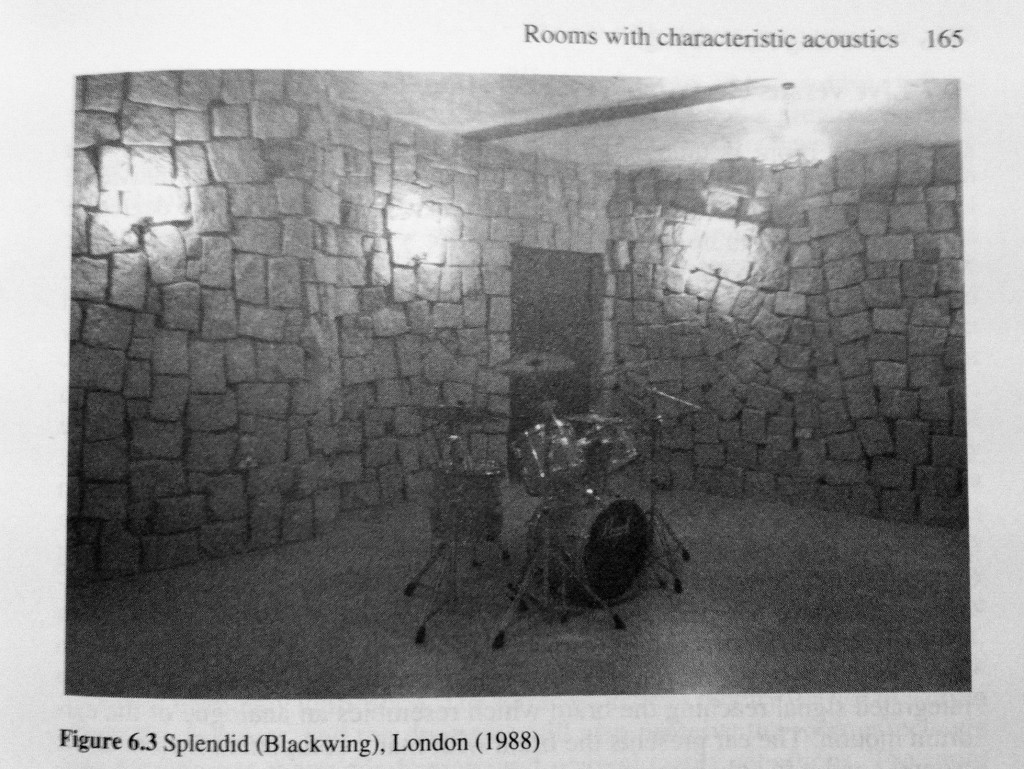
- Blackwing studio stone room, where Loz was holed up for the Nowhere sessions (photo from Recording Studio Design by Philip Newell)
When I finished university I had £500 left from a combination of my grant (remember those?) and prize money (English and overall academic achievement prizes), so I headed to Denmark Street in London and got myself a black Musicman Stingray like Steve – I’d coveted his ever since I first plucked a note on it. Though I ended up playing in a funk based band from the mid-90s until 2008 I always carried musical lessons I’d learned from Ride, seeing them write, rehearse, record, refine and perform their songs, and in recent years my musical direction has moved ever more steadily towards those formative experiences. Alongside my older brother these guys are my major musical influence. Not only did I witness their early musical development up close, but touring with them and getting regular guest list passes years after I got to see a great many bands (Nick Cave and the Bad Seeds, The Cure, Teenage Fanclub, Pale Saints, Pixies, Nirvana, Public Enemy….). I got to see how people in the music industry worked, and that taught me a great many lessons – in fact, I was often baffled as to why people would come up to me backstage asking where ‘so-and-so’ was whilst looking furtively this way and that – ahhh, such an innocent!
I have no idea whether I was any good as a roadie and I tend to remember the problems, not the successes, such as sending Mark onto stage with an oddly tuned Fender Jaguar (I think I’d had a few beers/smokes too early in the proceedings), staring at a festival audience whilst Loz’s cymbal stand flopped over, and desperately trying to restring Andy’s 12-string Rickenbacker before the next song whilst a smoke machine made it impossible to see my own hands! For the sake of balance I’m sure I fucked up something for Steve, but I can’t remember it right now.
Just before Ride announced their reunion I met Mark at a show in Bristol where he was touring as support for Thurston Moore; he gleefully informed me that they’d be breaking the news the following week. It was lovely to see him again after all these years and as I walked home it seemed like a floodgate of memories from my brief time with them opened up – I couldn’t really sleep that night as a result. The next day I put on FYT by This Mortal Coil, their original intro music, and sure enough it brought back the same old butterflies I’d feel before they hit the stage.
Seeing them recently at Camden Roundhouse I thought hearing FYT would set me off again, but actually I felt satisfied that things were somehow right with the world (they’re obviously not, but that’s the magic of music). What followed was no mere nostalgia trip, despite the very particular age range of the audience, and I was treated to the kind of show they might have only dreamed of back in 1990. Fuck me, it was awesome and I’m so glad I got to enjoy it from in front of the PA and not standing at the side tuning guitars (no disrespect to their current roadcrew who are better qualified than I ever was). They played with a strength and surety I’d never seen the first time round, and yet without losing that essential Ride-ness that was in evidence even in 1989 – no mean feat. Though Vapour Trail is without a doubt a great song, I’d never had any emotional attachment to it, but hearing it live again just weeks after a tragic loss leant the words a poignancy that damn near floored me. Briefly catching up with a few of them after the show reminded me of why it had been such a positive experience all those years ago, but there was no way to articulate how much that experience had shaped me in the intervening years; I think I’d have appeared even more nuts than I probably did as I’d had a few pints.
So, after all these years I’d like to say thanks to Andy, Loz, Mark, Steve and in particular Dave.
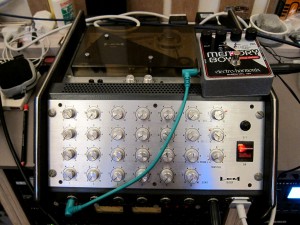 on of the song Redrum has a multi layered vocal that I felt needed some brash distortion, and having dismissed a selection of distortion/fuzz pedals I settled on a LEM Baby (Univox) solid state mixer which does a fine line in ear-torturing distortion. It also has a tape echo attached, but this was left off for the mix and substituted by a delay pedal at the input (an Electro-Harmonic Memory Boy). The vocal parts needed editing so, spotting an opportunity for sonic oddities, I left the tape echo running and removed the erase head that normally wipes the tape loop ready for a fresh echo round.
on of the song Redrum has a multi layered vocal that I felt needed some brash distortion, and having dismissed a selection of distortion/fuzz pedals I settled on a LEM Baby (Univox) solid state mixer which does a fine line in ear-torturing distortion. It also has a tape echo attached, but this was left off for the mix and substituted by a delay pedal at the input (an Electro-Harmonic Memory Boy). The vocal parts needed editing so, spotting an opportunity for sonic oddities, I left the tape echo running and removed the erase head that normally wipes the tape loop ready for a fresh echo round. 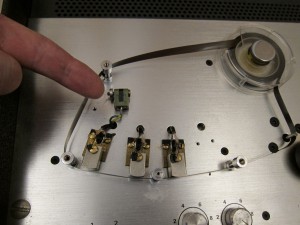 The LEM Baby tape loop is very long, taking around a minute to repeat. The editing lasted a good few minutes, leaving the tape saturated in the massed vocals, devoid of any synchronous aspect. On top of this, the tape loop is knackered and the moving parts in need of lubrication, which causes hideous slurring (traditionally called ‘wow and flutter’).
The LEM Baby tape loop is very long, taking around a minute to repeat. The editing lasted a good few minutes, leaving the tape saturated in the massed vocals, devoid of any synchronous aspect. On top of this, the tape loop is knackered and the moving parts in need of lubrication, which causes hideous slurring (traditionally called ‘wow and flutter’).
